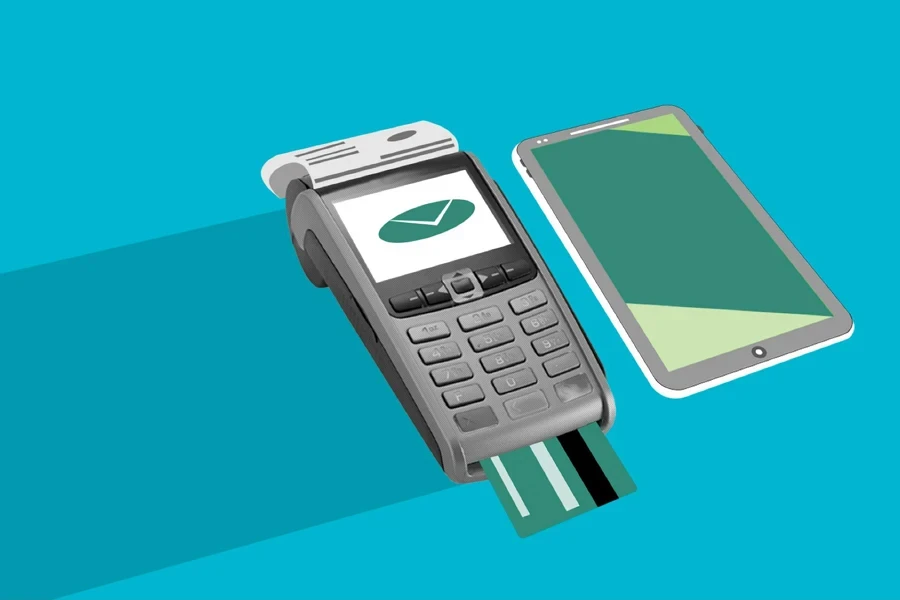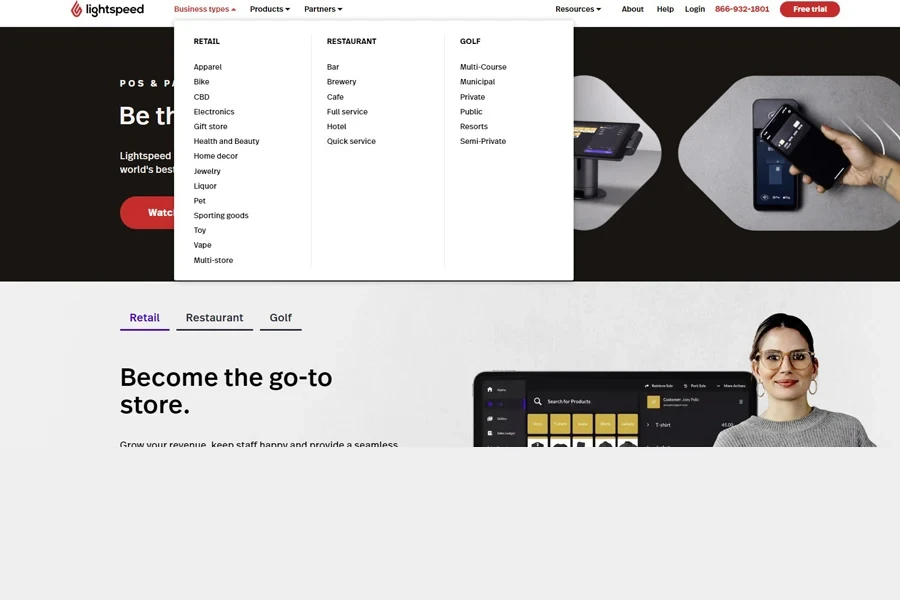The race against efficiency in e-commerce is about having a reliable point-of-sale (POS) system for your online store that speeds up checkouts, keeps your inventory organized, and helps you remember your customers.
The best part about an e-commerce POS system is that it can connect your online store with your physical store, if you have one. Imagine processing orders smoothly, automating those boring tasks, and getting real-time data on how your business is doing—all thanks to a clever POS system.
This guide will show you what to look for in a POS system, like easy integration with your existing product details, a user-friendly interface (so anyone can use it), and awesome reporting features.
Table of Contents
Why use a POS system in e-commerce?
Top features to look for in an e-commerce POS system
Security considerations for e-commerce POS systems
Top 3 e-commerce POS systems
Summary
Why use a POS system in e-commerce?

Juggling inventory, tracking sales, and processing transactions is enough to make your head spin. But with a cloud-based POS system, you can automate the tedious stuff: transactions, inventory, sales tracking, and more. There will be no more manual data entry or costly mistakes since the POS lets you focus on sales while the tech handles the grunt work.
Big names in e-commerce, like Shopify and BigCommerce, know that an up-to-date POS system can enhance your customers’ shopping experience and give you a clear picture of your whole business.
Cloud-based POS systems let you access real-time data from anywhere, allowing you to make smart decisions on the fly and keep your operations smooth. Forget scrambling to accept the latest payment methods—mobile payments and e-wallets—these POS systems handle everything.
Customers today crave convenience, and cashless options are king (mobile transactions in the US hit a whopping US $745 billion in 2019!). POS systems keep your customers happy with fast, secure checkouts.
Real-time tracking makes inventory management easier, as you’ll avoid stockouts or overbuying. However, POS systems offer more valuable data on sales trends, customer preferences, and peak business hours.
Top features to look for in an e-commerce POS system

Efficient stock control
No more stockout sweats since a POS system is literally your personal stockroom assistant (minus the coffee breaks). It tracks inventory across all your sales channels in real-time, so you’ll never be caught with empty shelves for your hot sellers or stuck with outdated stuff nobody wants.
Low-stock alerts keep you informed, and automatic reorder suggestions make restocking a breeze. Detailed reports help you find the perfect balance for your inventory, keeping customers happy and your money flowing.
Seamless payment transactions
These days, smooth checkout is key to keeping shoppers happy. Your POS system handles everything from classic credit cards to the latest mobile wallets, like Apple Pay.
Some even accept cryptocurrency! No matter how much your customers want to pay, your POS keeps the checkout line moving. Secure, PCI-compliant processing ensures their sensitive data is safe and sound.
Data-driven analytic
By data-driven analytics, we mean detailed reports showing sales trends, peak selling periods, and profit margins. You’ll see exactly what’s selling, when, and how much money you make. With clear breakdowns by product or category, you can identify growth opportunities and tweak your sales strategies for optimal impact.
Building loyalty
Your POS system’s built-in CRM features help you achieve strong customer bonds. It tracks purchase history, manages detailed customer profiles, and lets you launch targeted marketing campaigns that resonate with your audience.
Understanding your customers’ preferences and behavior gets easier, allowing you to personalize their experience and build rock-solid loyalty that keeps them returning for more.
Integration with e-commerce platforms
Handling multiple sales channels can be a nightmare—unless you have a POS system that seamlessly integrates with your online store and those big-name marketplaces. With this integration, your inventory, sales data, and customer information all sync across platforms.
Security considerations for e-commerce POS systems

PCI compliance
First, if you accept plastic, you must comply with the Payment Card Industry Data Security Standard (PCI DSS). This comprehensive requirement sets out precise security controls for processing, storing, and transmitting cardholder data.
It includes strong access controls, secure networks, data protection, and vigilant monitoring and testing protocols. Non-compliance isn’t an option—PCI violators face massive penalties and audits.
A single data breach is often catastrophic for customer trust and brand reputation. Achieving and maintaining PCI compliance ensures your POS has that essential security baseline covered.
Encryption

Even if hackers intercept your data, encryption ensures it’s useless gibberish without the proper decryption key. Your POS should employ end-to-end encryption (E2EE) to scramble sensitive details from the moment they’re entered until they reach their final destination.
Leading providers like Square and Shopify utilize advanced encryption algorithms to safeguard transactions and customer information at every step.
Access controls
You wouldn’t leave your store unlocked at night, right? The same logic applies to your POS system’s virtual gateways. Robust access control measures like unique logins, role-based permissions, and multi-factor authentication (MFA) restrict who can access what data and functionalities.
This prevents unauthorized exploits by both external threats and rogue insiders. Consistent password updates and detailed audit trails allow you to monitor access attempts and catch breaches early. By limiting data pathways, you drastically reduce your exposure.
Audits and updates
Technology evolves rapidly, and so do cyber threats. Regular security audits expose new vulnerabilities in your POS setup before incidents occur. Audits also verify compliance with the latest standards, like PCI DSS, giving you peace of mind.
Similarly, POS vendors frequently release software patches that address new risks and close security holes. Promptly installing these critical updates is a must for an impenetrable defense. Audits expose cracks, while updates seal them up—it’s an ongoing cycle of vigilance.
Top 3 e-commerce POS systems
1. Shopify POS

Juggling an online store and a brick-and-mortar shop can feel like a three-ring circus. Shopify POS integrates smoothly with your existing Shopify store, creating a central hub for managing everything—sales, inventory, and customer data—in one place.
Real-time inventory syncing means no more overselling—you’ll always have a clear picture of what’s in stock, both online and on your shelves. Plus, it handles all the major payment methods securely, keeping your customers’ data safe.
Shopify POS is more than just a fancy cash register. It generates reports and analytics you can actually understand, helping you make smart decisions for your business. The best part is that you can customize the hardware to fit your needs, like building your dream POS team.
2. Lightspeed Retail

Lightspeed Retail is a real powerhouse for e-commerce thanks to its top-notch inventory management. You can track stock quickly, upload products in bulk, and get detailed reports. It’s like having a super-organized stockroom manager who never sleeps.
Managing multiple locations isn’t cumbersome, unlike traditional payment processing methods. Now, let’s talk about payments. This system handles everything—credit cards, debit cards, mobile payments, you name it. And it’s all locked down tight with serious security. Your customers can pay however they want, and you can sleep easy.
Here’s where it gets cool—the reporting. Lightspeed dishes out detailed insights on sales trends, how your staff is performing, and what your customers are up to. You’ll know what’s selling, when, and who’s buying it.
On the customer relationship front, you can build detailed customer profiles, track their purchases, and hit them with targeted marketing.
Lightspeed integrates seamlessly with other platforms, including e-commerce, accounting software like QuickBooks, and other tools.
3. Square POS

Square POS isn’t just another point-of-sale system; it’s a fit for businesses of all sizes. From corner cafes to booming online stores, Square adapts to your needs without the usual hassle.
Their free basic app tracks inventory, analyzes sales, and processes payments—all without breaking the bank. When we talk about payments, we mean everything from credit cards to the latest crypto.
Security is a big deal, and Square doesn’t mess around. With PCI compliance, your customers’ data is locked down tight.
Square relieves you of the inventory headache in several ways. Real-time stock levels, bulk product uploads, multi-location syncing—it’s all there. But it’s the reporting that really shines. Sales trends, staff performance, and customer insights—Square gives you the data to make smart calls and grow your business.
Do you need it to work with your other tools? No problem. Square POS is compatible with popular accounting software and e-commerce platforms. They offer hardware for every need, from basic card readers to full register setups.
Summary
These new point-of-sale systems keep your inventory sharp—no more stock-out surprises, no more apologizing to customers. Payments are seamless, too, from credit cards to fancy new wallets, all secured with bank-level encryption to keep your customers’ data safe.
E-commerce POS systems are like having a 24/7 business analyst on staff. They crunch the numbers, telling you what’s selling and what’s not moving, helping you identify areas for growth. Plus, they help you understand your customers better, remembering their preferences so you can target them with the perfect deals at the perfect time.
So, whether you choose Shopify, Lightspeed, Square, or another option, picking the right POS is like hiring a supercharged assistant who never sleeps.



